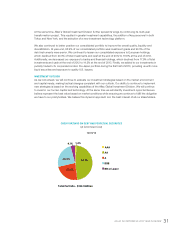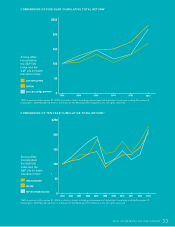Aflac 2013 Annual Report Download - page 38
Download and view the complete annual report
Please find page 38 of the 2013 Aflac annual report below. You can navigate through the pages in the report by either clicking on the pages listed below, or by using the keyword search tool below to find specific information within the annual report.
Aliated Corporate Agency – Agency in Japan directly
affiliated with a specific corporation that sells insurance
policies primarily to its employees
Benefit Ratio – Incurred claims plus the change in reserves
for future policy benefits, as a percentage of total revenues
Earnings Per Basic Share – Net earnings divided by the
weighted-average number of shares outstanding for the period
Earnings Per Diluted Share – Net earnings divided by the
weighted-average number of shares outstanding for the period
plus the weighted-average shares for the dilutive effect of
share-based awards outstanding
Group Insurance – Insurance issued to a group, such as an
employer or trade association, that covers employees or
association members and their dependents through certifi-
cates of coverage
Individual Insurance – Insurance issued to an individual
with the policy designed to cover that person and his or her
dependents
In-force Policies – A count of policies that are active contracts
at the end of a period
Net Investment Income – The income derived from interest
and dividends on investment securities, after deducting
investment expenses
New Annualized Premium Sales – Annual premiums, on
policies sold and incremental increases from policy conver-
sions, collected over a 12-month period, assuming the policies
remain in force
Operating Earnings Per Share – Profits per share derived
from operations before realized investment gains and losses
from securities transactions, impairments, and derivative and
hedging activities, as well as nonrecurring items
Perpetual Securities – Financial instruments that have
characteristics of both stocks and bonds. These investments
are subordinate to senior bonds, but rank higher than equities
and generally rank higher than preferred stock. A perpetual
security does not have a stated maturity date, but instead
typically has what is sometimes referred to as an economic
maturity. An economic maturity is a date at which a perpetual
security is expected to be redeemed by the issuer
Persistency – Percentage of premiums remaining in force
at the end of a period, usually one year. For example, 95%
persistency would mean that 95% of the premiums in force at
the beginning of the period were still in force at the end of the
period
Premium Income – Revenues that an insurer receives as
premiums paid by its customers for insurance products
Realized Investment Gains and Losses – Securities transac-
tions, impairments, and derivative and hedging activities that
generate a securities’ value at more than book value, which is
a gain; or less than book value, which is a loss
Return on Average Invested Assets – Net investment
income as a percentage of average cash and investments at
amortized cost
Risk-based Capital (RBC) Ratio – Statutory adjusted capital
divided by statutory required capital. This insurance ratio is
based on rules prescribed by the National Association of
Insurance Commissioners (NAIC) and provides an indication
of the amount of statutory capital the insurance company
maintains, relative to the inherent risks in the insurer’s
operations
Solvency Margin Ratio (SMR) – Solvency margin total divided
by one half of the risk total. This insurance ratio is prescribed
by the Japan Financial Services Agency (FSA) and is used for
all life insurance companies in Japan to measure the adequacy
of the company’s ability to pay policyholder claims in the event
actual risks exceed expected levels
Total Return to Shareholders – Appreciation of a shareholder’s
investment over a period of time, including reinvested cash
dividends paid during that time
Voluntary Supplemental Insurance – Benefits purchased by
a consumer at the consumer’s own expense in addition to a
(typically employer-provided) major medical plan that cover
out-of-pocket expenses not typically covered under
the primary insurance policy
GLOSSARY OF SELECTED TERMS
36 AFLAC INCORPORATED 2013 YEAR IN REVIEW
















